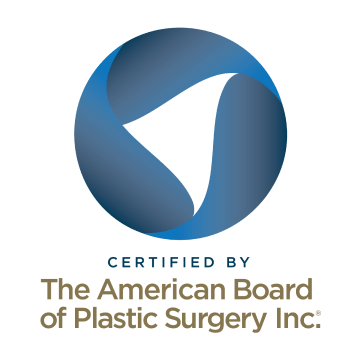If you are seeking breast augmentation in San Diego, there are a number of options in size and shape of your implants to consider, but the age old question remains; saline or silicone? Both saline and silicone can achieve fullness, balance, and symmetry in breast augmentation patients, but each implant type features its own unique advantages and it’s important to choose the implant that will best fit your lifestyle and goals.
Both saline and silicone can achieve fullness, balance, and symmetry in breast augmentation patients, but each implant type features its own unique advantages.
Board certified plastic surgeon Dr. Katerina Gallus loves to share her breast augmentation expertise and has written the following primer on silicone vs. saline to help you know which implant would best suit you and your aesthetic vision. Let’s dive in!
Saline implants in San Diego
Saline breast implants have been a trusted option for decades, having been in continuous use for cosmetic breast augmentation since their introduction in the 1960s. They come in a full range of sizes and various profiles (the profile of an implant determines how much projection outward from the chest the implant will provide).
However, today saline implants are only chosen by a minority of breast augmentation patients because safe, modern fifth-generation cohesive silicone breast implants have largely taken over the market—their thicker viscosity and lighter weight better mimics natural breast tissue.
That said, saline implants are preferred by some, with patients generally choosing them for potential safety advantages. Understanding more about saline implants can help you decide if they are right for you.
Did you know saline implants also include silicone materials? This is because saline breast implants rely on a flexible silicone outer shell which is filled with saline solution (sterile salt water). Most saline implants are placed while empty and filled after being situated in the breast pocket, allowing for smaller breast augmentation incisions.
Candidates for saline breast implants
Saline breast implants may be right for you if:
- You have a good amount of existing breast tissue. Saline implants may show rippling if you have thinner breast tissue, but that can be minimized by slightly overfilling the implant. This would create a firmer breast feel which may or may not be preferable, depending on your goals. If you have enough breast tissue to sufficiently cover the implant, rippling is not as likely to be an issue and the implant would not need to be overfilled.
- You prefer a shorter scar. Saline implants can be filled after placement, allowing your plastic surgeon to make smaller inframammary or periareolar access incisions. They are also employed for specialty implant placement techniques, including the use of transaxillary (through the armpit) or transumbilical (through the belly button) incisions.
- You are younger than 22 years old. Saline implants are FDA-approved for patients 18 and older; silicone implants are approved for patients 22 and older. You may still choose silicone implants if you are younger than 22, as many women do—though the breast implant manufacturer may not honor the warranty if the implant was placed before the age of 22. This age restriction is primarily due to the regulatory history of breast implants and not for safety concerns.
- You do not want to monitor your breast implants with regular screenings. The FDA recommends monitoring silicone implants with MRI or ultrasound scans for possible ruptures 5 years after placement and every 2-3 years thereafter. This is completely optional but recommended as a ruptured silicone implant may be undetectable by look and feel alone. If a saline implant ruptures, it will quickly deflate and the sterile solution will be safely absorbed and naturally expelled from your body.
Disadvantages of saline implants
Saline breast implants:
- Are firmer and heavier than silicone implants
- Are more likely to show wrinkling or rippling
- Can sometimes be felt through the skin
- May not look and feel as natural if patients have thin breast tissue
- Will visibly deflate if ruptured
For these reasons, saline-filled implants continue to be chosen by fewer patients in favor of today’s redesigned silicone-filled implants.
Silicone breast implants
Silicone breast implants consist of a silicone outer shell that is pre-filled with a cohesive silicone gel and come in a variety of sizes, shapes, and styles to achieve a personalized look.
Silicone breast implants were first invented in 1961 and have gone through a significant evolution through the years. They were pulled from the cosmetic breast augmentation market in 1991 for health concerns related to migrating silicone, but reintroduced in 2006 with cohesive fill and improved shell technology offering improved durability and safety. Since that time, they have quickly risen to again become the favorite choice of patients for their wonderfully natural feel.
Candidates for silicone breast implants
Silicone breast implants may be right for you if:
- You desire a more natural feel. Silicone gel-filled implants feel and behave more like natural breast tissue inside the breast.
- You have a small amount of existing breast tissue. A minimal bustline makes concealing implants more challenging. Silicone implants’ viscous filling is less prone to create visible rippling, which is ideal for patients with minimal natural breast tissue. That said, even patients with considerable existing breast tissue typically favor the natural look and feel of silicone implants.
- You desire a shaped implant. The wider range of silicone implant shape and profile options can help you achieve your desired look.
Disadvantages of silicone implants
Silicone breast implants:
- Require a slightly larger incision and have fewer incision site options
- Are only available for off-label use in patients under age 22
- May necessitate MRI or ultrasound screenings to monitor for or confirm implant rupture
Whether you ultimately choose silicone or saline breast implants, successful breast augmentation is completely dependent on choosing an experienced, board certified plastic surgeon that can guide you towards the best choices and successfully create your desired look.
La Jolla breast augmentation consultation with Dr. Gallus
Restore SD Plastic Surgery helps La Jolla breast augmentation patients visualize their options with Vectra 3D Imaging. Dr. Gallus will take your photos and use the imaging system to simulate different implant sizes, shapes, placement, etc., to empower you about your procedure and help you feel confident in your choices. Dr. Gallus is passionate about educating her patients on their options, sharing her professional recommendations, and supporting her patients’ informed decisions.
Because your safety is the number one priority at Restore SD Plastic Surgery, Dr. Gallus exclusively operates in a private, Quad A-accredited surgical facility located within her practice. Quad A accreditation is considered the “gold standard” for quality and safety.
You can get to know Dr. Katerina Gallus and learn more about breast augmentation and other plastic surgery procedures on her YouTube channel, where she offers a compassionate, female perspective on cosmetic medicine as well as life!
Our San Diego plastic surgery office
If you are considering breast augmentation in the San Diego or La Jolla area, Dr. Gallus would love to meet with you, listen to your goals, and create a treatment plan designed to enhance your natural beauty. Schedule your consultation at Restore SD Plastic Surgery by calling (858) 224-2281 or contact us online.
Areas served:







